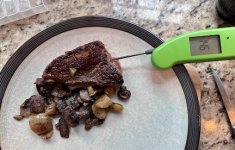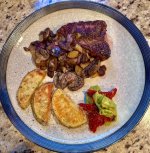I tried this CI recipe mostly out of curiosity as it was so unusual. Wow, were these good!! Definitely line your sheet pan with foil for easy cleanup.
I used russets, as that's what I had on hand. Made these twice, the first time I halved the recipe and guessing my math wasn't great as I had a hard time getting the slurry to be pudding-like, but eventually got there...... They will look like something you don't want to eat before baking, but trust the process!

Thick Cut Fries
WHY THIS RECIPE WORKS
When traditional French fries are fried, water is rapidly driven out of the starch cells at the surface of the potato, leaving behind tiny cavities. It's these cavities that create a delicate, crispy crust. Since oven fries don't heat fast enough for air pockets to form, we instead coat the potatoes in a cornstarch slurry that crisps up like a deep-fried fry would. We arranged the coated planks on a rimmed baking sheet that we coated with both vegetable oil spray and vegetable oil; the former contains a surfactant called lecithin, which prevents the oil from pooling and, in turn, prevents the potatoes from sticking. Using the oil spray also allowed us to use only 3 tablespoons of oil, just enough to evenly coat the fries. Covering the baking sheet with aluminum foil for the first half of cooking ensures that the potatoes are fully tender by the time they are browned.
Thick-Cut Oven Fries
INGREDIENTS
3 tablespoons vegetable oil
2 pounds Yukon Gold potatoes, unpeeled (I used russets)
¾ cup water
3 tablespoons cornstarch
Salt
*
BEFORE YOU BEGIN
Choose potatoes that are 4 to 6 inches in length to ensure well-proportioned fries. Trimming thin slices from the ends of the potatoes in step 2 ensures that each fry has two flat surfaces for even browning. This recipe's success is dependent on a heavy-duty rimmed baking sheet that will not warp in the heat of the oven. Spraying the sheet with vegetable oil spray will help the oil spread evenly and prevent sticking. The rate at which the potatoes brown is dependent on your baking sheet and oven. After removing the foil from the baking sheet in step 5, monitor the color of the potatoes carefully to prevent scorching.
1
INSTRUCTIONS
Adjust oven rack to lowest position and heat oven to 425 degrees. Generously spray rimmed baking sheet with vegetable oil spray. Pour oil into prepared sheet and tilt sheet until surface is evenly coated with oil.
2
Halve potatoes lengthwise and turn halves cut sides down on cutting board. Trim thin slice from both long sides of each potato half; discard trimmings. Slice potatoes lengthwise into ⅓- to ½-inch-thick planks.
3
Combine water and cornstarch in large bowl, making sure no lumps of cornstarch remain on bottom of bowl. Microwave, stirring every 20 seconds, until mixture begins to thicken, 1 to 3 minutes. Remove from microwave and continue to stir until mixture thickens to pudding-like consistency. (If necessary, add up to 2 tablespoons water to achieve correct consistency.)
4
Transfer potatoes to bowl with cornstarch mixture and toss until each plank is evenly coated. Arrange planks on prepared sheet, leaving small gaps between planks. (Some cornstarch mixture will remain in bowl.) Cover sheet tightly with lightly greased aluminum foil and bake for 12 minutes.
5
Remove foil from sheet and bake until bottom of each fry is golden brown, 10 to 18 minutes. Remove sheet from oven and, using thin metal spatula, carefully flip each fry. Return sheet to oven and continue to bake until second sides are golden brown, 10 to 18 minutes longer. Sprinkle fries with ½ teaspoon salt. Using spatula, carefully toss fries to distribute salt. Transfer fries to paper towel–lined plate and season with salt to taste. Serve.
I used russets, as that's what I had on hand. Made these twice, the first time I halved the recipe and guessing my math wasn't great as I had a hard time getting the slurry to be pudding-like, but eventually got there...... They will look like something you don't want to eat before baking, but trust the process!


Thick Cut Fries
WHY THIS RECIPE WORKS
When traditional French fries are fried, water is rapidly driven out of the starch cells at the surface of the potato, leaving behind tiny cavities. It's these cavities that create a delicate, crispy crust. Since oven fries don't heat fast enough for air pockets to form, we instead coat the potatoes in a cornstarch slurry that crisps up like a deep-fried fry would. We arranged the coated planks on a rimmed baking sheet that we coated with both vegetable oil spray and vegetable oil; the former contains a surfactant called lecithin, which prevents the oil from pooling and, in turn, prevents the potatoes from sticking. Using the oil spray also allowed us to use only 3 tablespoons of oil, just enough to evenly coat the fries. Covering the baking sheet with aluminum foil for the first half of cooking ensures that the potatoes are fully tender by the time they are browned.
Thick-Cut Oven Fries
INGREDIENTS
3 tablespoons vegetable oil
2 pounds Yukon Gold potatoes, unpeeled (I used russets)
¾ cup water
3 tablespoons cornstarch
Salt
*
BEFORE YOU BEGIN
Choose potatoes that are 4 to 6 inches in length to ensure well-proportioned fries. Trimming thin slices from the ends of the potatoes in step 2 ensures that each fry has two flat surfaces for even browning. This recipe's success is dependent on a heavy-duty rimmed baking sheet that will not warp in the heat of the oven. Spraying the sheet with vegetable oil spray will help the oil spread evenly and prevent sticking. The rate at which the potatoes brown is dependent on your baking sheet and oven. After removing the foil from the baking sheet in step 5, monitor the color of the potatoes carefully to prevent scorching.
1
INSTRUCTIONS
Adjust oven rack to lowest position and heat oven to 425 degrees. Generously spray rimmed baking sheet with vegetable oil spray. Pour oil into prepared sheet and tilt sheet until surface is evenly coated with oil.
2
Halve potatoes lengthwise and turn halves cut sides down on cutting board. Trim thin slice from both long sides of each potato half; discard trimmings. Slice potatoes lengthwise into ⅓- to ½-inch-thick planks.
3
Combine water and cornstarch in large bowl, making sure no lumps of cornstarch remain on bottom of bowl. Microwave, stirring every 20 seconds, until mixture begins to thicken, 1 to 3 minutes. Remove from microwave and continue to stir until mixture thickens to pudding-like consistency. (If necessary, add up to 2 tablespoons water to achieve correct consistency.)
4
Transfer potatoes to bowl with cornstarch mixture and toss until each plank is evenly coated. Arrange planks on prepared sheet, leaving small gaps between planks. (Some cornstarch mixture will remain in bowl.) Cover sheet tightly with lightly greased aluminum foil and bake for 12 minutes.
5
Remove foil from sheet and bake until bottom of each fry is golden brown, 10 to 18 minutes. Remove sheet from oven and, using thin metal spatula, carefully flip each fry. Return sheet to oven and continue to bake until second sides are golden brown, 10 to 18 minutes longer. Sprinkle fries with ½ teaspoon salt. Using spatula, carefully toss fries to distribute salt. Transfer fries to paper towel–lined plate and season with salt to taste. Serve.


